TOWARD A MUSIC OF THE HYPERSPHERES
By BUZZ KIMBALL
In conversations prior to the publication of this article, author
Buzz Kimball commented that he would try to go easy and write something
that would not offend too many people. One might ask, “how
could an article on microtonal ensembles offend people?” But Buzz
is an observer and commentator as much as he is an instrument maker. In
describing the instruments of an accessible and affordable microtonal
ensemble, he has come up with a few things to say on peripheral subjects
as well.
Should the making of unconventional instruments be seen as a
stance in opposition to restrictive external forces, or simply as an act
of creative expression? Here are some thoughts on that subject, and here
too are practical ideas on instruments for intonational exploration.
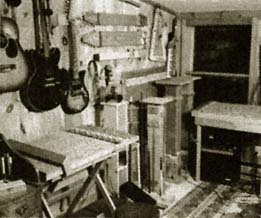
WALL TO WALL MICROTONES, or
“how not to get tripped upon a microtone”
|
Environment, more than anything, influences what a
listener deems to be good music. Music at its bare is simply a chemical
reaction; the hairlike cilia of the inner ear convert mechanical
vibrations to electro-chemical neuron signals. Many theories of musical
organization exist; in fact, a huge literature surrounds the western 12
tone scale. But perhaps it is the dead weight of tradition that holds
the piano scale in such esteem. Conventions are probably the greatest
barrier to rational inquiry and progress in music. The hearing mechanism
is completely and totally aurally neutral, and it is probably only
through “proper indoctrination” that we come to know what we
like.
There is a noticeable lack of individuality in
contemporary music. MTV always seems to sound alike; orchestral
performers look ready to fly apart at the seams from the frenzied
ceaseless motions. Against this backdrop, it may well be that the prime
directive for contemporary musicians is to explore new sounds on new
instruments. Whether the creative musician must rebel against human
exploitation and subservience to the dehumanizing factory system (ergo
welfare/warfare state), or just take a hint from nature and gyrate
towards a musical system which is more consistent with the bio-chemical
need which it fulfills, becomes a moot point.
Looking back at my own work, it seems surprising that
I actually built any instruments, much less an ensemble of microtonal
instruments capable of experimenting in a variety of equal temperaments
and forms of just intonation. Having rejected our frivolous
materialistic society as an adolescent, it seems only logical that I
would fall afoul of chemical addictions on becoming an adult voting
member of our interesting but decadent “American way of
life.” I really do think that exploring the forbidden sonic
spectrum is what helped me break out of chemically-induced inertia.
Playing a microtonal instrument does, quite literally, put infinity in
your hands. So — no more living in “beam me up,
Scotty” land. Get a piece of real adventure; not some fantasy
dreamed up by the Hollywood mogul sluts to part you from your money.
But, of course, a vessel is needed to contain
musical sounds in our universe for their brief visit.

NOVOSLIDE GUITARS
#2 3, & 4.
|
Four basic elements of new music design are:
functionalism, flexibility, finances and floorspace. Being a
functionalist suggests that ornate decorations and shiny metal are
undesirable qualities in an experimental instrument. They take time and
resources better spent in making an instrument sound better, and
besides, it can be a real drag to strip off reusable parts from an
instrument that a great deal of effort has been devoted to. Once, when
my microtonal guitar collection had become too large, I decided to
dispose of two mangy specimens that never seemed right despite immense
labors that had gone into them. The only consolation I had was the
recovery of the hardware, which enabled me to build a couple of slide
guitars, instruments I had wanted for some time.
It would be nice to have a single instrument able
to playing all the experimental scales, as in sliding instruments
capable of continuous pitch gradations. A flexible intonation instrument
is desirable because of finances (one instrument, many possible scales).
But there seems to be a trade off between ease of playing and what is
possible to play, since it is more difficult to accurately select
specific pitches from an infinity of possibility. And a fixed pitch
instrument has the advantage that it will entice one out of scale
patterns and into trying and hearing something altogether different.
The wonders of Reaganomics have made materials
expensive, but it is possible to build a variety of good sounding
instruments capable of a full range of expressive experimental
intonations. And since two thousand units in an eight hour shift is not
a consideration, expensive power tools are not a requirement. Hand saw,
drill, hammer, and screw driver are more than adequate to start.
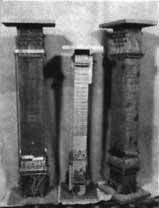
L-R: BASS BEAM, SCREAMING YELLOW ZONKER, HARMOLYRA
|
String instruments for intonational exploration may be plucked or bowed,
fretted or played with a slide. If flexible string tuning is not needed,
piano or zither pins are the most cost effective tuning mechanism.
Obviously, tuning gears are too expensive for instruments with large
numbers of strings. Slide guitar provides a great deal of flexibility in
intonation, but it can be a difficult and demanding instrument, since
there aren’t any basic patterns. Instead there is an indeterminate
flux. Slide instruments can have a group of strings on just one side of
the instrument, or on two or more sides. By having sets of strings in
different tunings on each side, the basic 4x4 or 6x6 beam can provide a
useful instrument packed with a lot of pitch relationships in a small
place. A 2x4 or 2x6 can provide a foundation for a two sided slide
instrument. A nominal amount of money for tuning gears and pickups can
make for an effective lap slide. I generally utilize guitar pickups,
which are configured for six strings, so I have to use 6 or 12 strings
in a group. A steel string of a given gauge and length has over an
octave of useable range so a great deal of flexibility in tuning is
available.
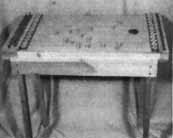
ACOUSTICAL HARMONIC KANON
|
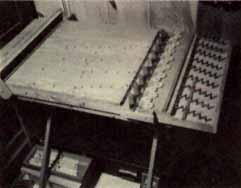
AMPLIFYING HARMONIC KANON
|
Plucked open string instruments can provide a set of discrete pitches,
in contrast to the slide’s continuous pitch change. I have found a
simple inexpensive design for harmonic kanons and microtonal harps. Nor
is it an original design; I just don’t remember where I picked it
up from. It fulfills basic considerations such as material cost,
strength, good sound, and visual appeal, as well as compactness and
intonational flexibility. The cigar box design, as I call it, appears to
be a derivative of the hammer dulcimer. Never ever being able to find
spruce soundboards in the width I needed spurred me on to using some
scraps of 1/4″ fir luan. Although too thick for use as soundboards
for instruments with nylon strings, this material sounds excellent with
steel strings and is ideal for electro-acoustical applications. Wood
pieces sandwiched between luan will make a strong and simple resonant
sound box. The location of the tuning and hitch pins will control the
spacing of strings and eliminate the need for head nuts or elaborate
tail bridges, and any thickness of string is proper.
Trying to create a microtonal ensemble is quite an
arduous task. Still, I occasionally feel guilty while plopping down in
front of the TV (plug-in drug) or while sucking down some brews, and
wonder if I would have done more. I was warned over a decade ago not to
expect to make friends for pursuing microtonality. And the advice was
correct. Although things have loosened up a bit, the economics of
microtones does have a tendency to preclude it from the marketplace.
1976, Syracuse, New York. Some friends of mine
— Jack, Steve, Corey ... we hit the rock shows coming through town
at the war memorial. Kiss, Grateful Dead, Blue Oyster Cult. Is
this supposed to be entertainment or a war zone? Best part of the show
is the Jack Daniels. But I would allow that it is less boring than
philosophy class.

REFRETTED GUITARS —
22tET, 22tET, 31tET, 31tET
|
Having gone from the piano to the electric guitar, I immediately started
refretting my guitars to microtonal scales when Ivor Darreg’s
article appeared in Guitar Player in February, 1978. [See also the
author’s article on refretting in EMI volume III #6, April 1988.]
About the same time I got a copy of Partch’s
Genesis of a
Music [New York; Da Capo Press, 1974]. I have two major grievences
with the bizarre cult he seems to have spawned. In
Genesis, Harry
jumps straight from the 5-limit ratios to the 11-limit. The 7-limit is
ignored and the 9-limit is dismissed.
Genesis is a good
introduction to Patch and his art but not a good handbook for learning
just intonation. Also, Partch’s early recordings are not readily
available, only his later work. In ten years I have yet to introduce
anybody to a later Partch recording and get a positive response. I was
much more interested in applying just intonation to electric instruments
and never could really justify the material cost or provide enough space
to directly copy a Partchian instrument. I was intrigued by the design
of the harmonic canon, but in retrospect I envisioned a design which is
a multi-string monochord and quite different from Partch’s design.
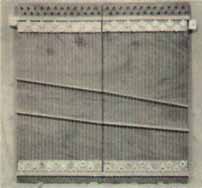
NOVOHARP
|
I don’t consider my instruments to be my children, since I have
always borrowed more than invented. But I may have lost as much as I
gained in trying to adapt conventional designs to non-conventional
intonation instruments. Many times I had tried to imagine what
Carillo’s pianos and Novarro’s harps would sound like. It
was only after building a simple electro-acoustic harmonic kanon that I
realized the two side by side would provide a simple, easily
transportable instrument. Hence, the novoharp, capable of an octave or
more in a wide range of higher order equal temperaments.
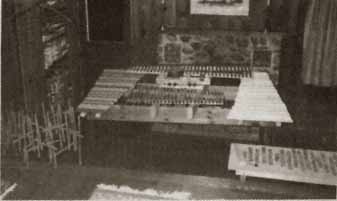
THE METAL ROOM IN THE TUBELY PALACE — Great chimes in 19tET, Tubulong in 17, 13 & 19tET and an 18 tone just
|
Probably the easiest metal to work with is electrical conduit. A quite
pleasing tone is produced from the pitch variation which is an inherent
by-product of the imperfections in the tubing. The tubulon (the name
often given to conduit marimbas) is a very underrated instrument which
anyone can afford and make in a couple of different scales. Not having
to be tuned between uses, they are a compelling alternative to watching
TV. Sort of the junk food microtonal instrument, good for indulging when
lacking concentration or discipline.
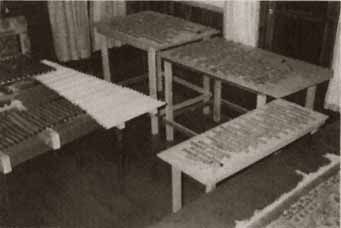
TUBULONG & 22 JUST METALLOPHONE
|
One instrument that I wanted for over a decade was, of course, a
Partchian marimba. However, several years ago I decided on an instrument
with metal bars instead, since the supervisor at a former jobsite let me
pick through the scrap barrels in the back of the fabrication plant.
After collecting bars in four metals and hundreds of widths and
thicknesses I picked a type I liked the most. Mild steel seemed
preferable to aluminum; steel has more inharmonicity and also will drive
electro-magnetic pickups, unlike aluminum. Aluminum also cools rapidly
and will clog the pores of a griding wheel. Needless to say the bars lay
around for more than a year, then a couple of dudes drove up from NYC
and bought two tubulons. With the money gleaned from that sale I was
able to buy a metal cutting bandsaw, and tuning the bars became
feasible. I set to work on a twenty-two note just, 111 bar metallophone.
After three years it is playable, but still needs resonators and
pickups.
The fact that my instrument collection works together
as an ensemble is both intentional and happenstance. Fundamental rules
that ensure a successful microtonal instrument are: be generous in the
number of pitches per octave included, and maintain fairly close and
accurate control over pitch. It is possible to only have a handful of
notes available on a simple instrument and produce a great deal of
melodic charm, but to explore the infinite possibilities of 20th century
liberated music, the old party line prevails — “the more,
the merrier.”
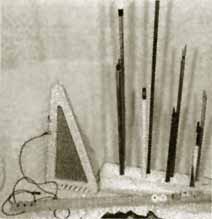
|
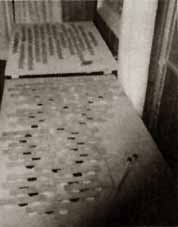
|
Miscellaneous: STICK HARP,
FLUTES, and (only partially shown)
LONG BOWED STICK INSTRUMENT
|
Detail — 22 NOTE JUST METALLOPHONE
with generalized bar pattern (in progress)
|
© Buzz Kimball
Introduction © Bart Hopkin
This article originally appeared in Experimental Musical Instruments, Volume VI, #1.